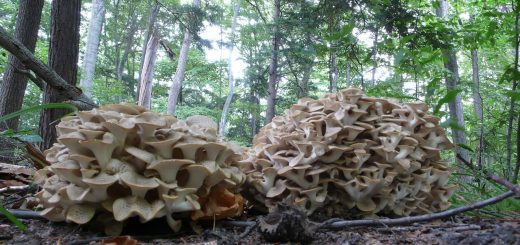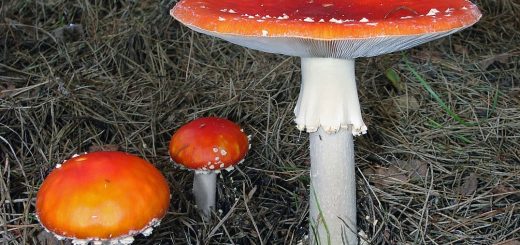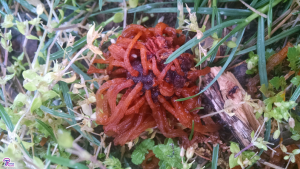#132: Microbotryum spp., the Anther Smuts
Of all the sexually transmitted infections in the world, the anther smuts are probably the most bizarre. Fungi in the genus Microbotryum infect plants in the pink family (Caryophyllaceae) as well as a few other species. When a plant infected with an anther smut tries to produce flowers, the fungus hijacks the process and forces the plant to make anther-like structures filled with fungal spores instead of pollen. The spores are primarily transmitted to new flowers by pollinators, but can also be spread by wind or splashing raindrops.
Anther smuts belong to the phylum Basidiomycota, subphylum Pucciniomycotina, class Microbotryomycetes, order Microbotryales, family Microbotryaceae, and genus Microbotryum. These organisms were once classified with the true smuts but are now known to be more closely related to the rusts. Like the rusts and smuts, anther smuts are obligate plant pathogens. Microbotryum species have evolved to parasitize plants in the family Caryophyllaceae, which includes pinks and carnations. A few of the fungi in this genus have managed to infect plants of other families, but they are not nearly as common.
The life cycle of an anther smut begins when a spore called a teliospore lands on the flower of a susceptible plant. Each teliospore has two copies of each chromosome contained in a single nucleus (“diploid,” denoted as 2n). In the right conditions, the spore germinates to produce a small structure called a basidium and then goes through meiosis, which results in four haploid nuclei (one copy of each chromosome, denoted by n). Each nucleus is then incorporated into a yeast-like cell called a “sporidium.” The sporidia are then released onto the flower, where they grow and divide like normal yeast. Sporidia are easily transferred to other parts of the plant by wind, raindrops, falling leaves/petals, and other processes.
When a sporidium encounters a sexually compatible sporidium and environmental conditions are right, the two sporidia fuse and begin their infective stage. After fusing, the fungus begins growing as a string of cylindrical cells called hyphae. Every cell is dikaryotic (denoted by n+n), meaning it contains two haploid nuclei: one from each original sporidium. The hyphae break through the outer surface of a leaf and begin to infect the plant’s tissues. At this point, the infection does not produce any symptoms. Before winter, the fungal infection reaches the plant’s meristems (basically, the centers where plant stem cells are kept) in the roots. There, the fungus can survive the winter and be sure of renewed plant growth in the spring.
Come spring, the plant sends out new growth from its meristems and the fungus promptly infects the new growth. In this way, the hyphae end up in every tissue of the plant. Despite suffering from a systemic infection, the plant does not show any symptoms until it flowers. Anther smuts are unique in that they force the plant to produce structures designed to release fungal spores. Since flowers can be male, female, or perfect, the fungus has to behave slightly differently for each flower sex.
In male flowers, the fungus grows into the anthers, which normally produce pollen. Once infected with the fungus, anthers are prevented from producing pollen and instead get filled with fungal cells. These fungal cells produce large quantities of teliospores, which eventually burst through the outer surface of the anther. The dikaryotic nuclei in the teliospore fuse to create a single nucleus with two copies of each chromosome (dikaryotic, 2n) prior to being released. The dark-colored, powdery teliospores look very different from pollen and give the flowers a sooty appearance once released. This feature of the Microbotryum life cycle resulted in the name “anther smut.” In female flowers, the fungus inhibits the development of the female parts and instead induces the flower to make stamen-like structures. As in male flowers, the anther at the top of each stamen becomes filled with teliospores. In perfect flowers, the anthers are coopted to produce spores and the female parts are inhibited.
Regardless of flower sex, end result is the same: absent or useless female parts and male parts appropriated for the production of fungal spores. Thanks to fungal modifications, the infected plant can neither spread its pollen nor produce pollenated seeds. The plant is therefore sterile and has been subjected to “parasitic castration.” Since the fungal infection is systemic, the plant will make only infected flowers in subsequent years.
The brilliant thing about the anther smut’s life cycle is that it spreads just like pollen normally would. Infected flowers still produce petals and nectar, which attract pollinators such as bees. While visiting an infected flower, these pollinators pick up the teliospores instead of pollen. As a result, the spores will be deposited on most of the flowers the pollinator visits afterward. Once landing on an uninfected plant, the fungus can begin its life cycle anew.
Anther smuts are not economically important, but they are very useful model systems for biologists. The most commonly researched anther smut system is Microbotryum violaceum on Silene species. Both flower and fungus can be found in the wild and easily grown in the lab, making the pair perfect for conducting in situ or in vitro studies. Additionally, these organisms have been minimally impacted by humans. For example, there has not been any widespread use of fungicides or herbicides against these species. Biologists use M. violaceum and Silene spp. to study various aspects of the host-parasite relationship, including: population dynamics, host specificity, host switching, and coevolution, just to name a few. Many of these concepts can be applied to other areas of biology, making anther smuts relevant to more than just mycology.
See Further:
http://www.genoscope.cns.fr/spip/-Microbotryum-violaceum-.html









![#011: Characteristics of Kingdom Fungi [Archived]](https://www.fungusfactfriday.com/wp-content/themes/hueman/assets/front/img/thumb-small-empty.png)

